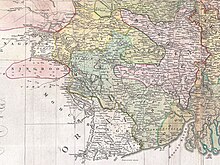Manbhum
This articleneeds additional citations forverification.(July 2013) |
| Manbhum | |
|---|---|
| 1833–1956 | |
 District map of Bengal administration | |
| Capital | |
| Area | |
• 1833 | 20,449 km2(7,895 sq mi) |
• 1901 | 10,741 km2(4,147 sq mi) |
| Population | |
• 1901 | 1,301,364[2] |
• 1931 | 1,810,890 |
| History | |
• Formation | 1833 |
• Disestablished | 1956 |
• Bifurcation | 1956 |
| Today part of | West Bengal(Purulia)Jharkhand(Dhanbad,Bokaro,Ranchi,Saraikela Kharsawan,East Singhbhum) |
Manbhum Districtwas one of the districts of theEast Indiaduring theBritish Raj.[3]AfterIndia's independence,the district became a part ofBihar State.Upon the reorganization of the Indian states in the mid-1950s, the Manbhum district waspartitionedbased on language. The Bengal-speaking areas were included inWest Bengal,while the rest were kept withBihar(present-dayJharkhand).
Etymology
[edit]Manbhum gets its name from the 16th century military generalMan Singh Iwho is known for his conquests Of Bihar, Odisha and parts of Bengal. He later also served as the governor (Subahdar) of this region during the reign of KingAkbar.[4]
In other versions, the district name derived fromManbazaror Manbhumkhasparganas.The headquarters of Jangal mahal region from around 1833 to 1838, when the district was formed.[5]
History
[edit]
In 1833, theEast India Companyformed the Manbhum district with its headquarters inManbazar,covering an area of 7,896 square miles, by dividing theJungle-Mahalregion to enhance administrative efficiency. In 1838, the headquarters shifted toPurulia,and over the following years, the district underwent several divisions. These divisions occurred in 1845, 1846, 1871, and finally, in 1879, reducing its size to 4,112 square miles. In 1901, the district area was 4,147 square miles, inhabited by a population of 1,301,364.[2]In 1912, Manbhum became a part of theBihar and Orissa Province.

On 1 April 1936, the Bihar and Orissa Province waspartitionedinto two separate provincesBiharandOrissabased on language, though Manbhum continued to remain a part of Bihar.Post-independence,linguistic tensionsemerged in the district due toimposition of Hindi languageover the nativeBengali-speakingmajority. This led to the establishment of the "State Reorganization Commission"on December 23, 1953. The commission recommended the creation of a new district named" Purulia, "primarily for Bengali speakers, by carving it out of the former Manbhum district in Bihar. The proposed Purulia district included 19 police stations from Manbhum, while 10 police stations from the Dhanbad sub-division and 2 police stations from the Purulia sub-division of Manbhum remained in Bihar.
Subsequently, three police stations ofWest Bengal—Ichagarh,Chandil,andPatamda—were transferred to Bihar upon a special request fromTISCO, Jamshedpur.The "Bengal-Bihar Border Demarcation"Bill was passed inParliamenton August 17, 1956, and inRajya Sabhaon August 28, 1956, ultimately receiving the signature of thePresident of Indiaon September 1, 1956. Consequently, on November 1, 1956,Puruliaofficially became a part of West Bengal, comprising 16 police stations, covering an area of 2,007 square miles (5,200 km2), and hosting a population of 1,169,097. However, other areas, including Ichagarh, Chandil, and Patamda, continued to remain under the jurisdiction of Bihar, with the former two became part of Saraikela, while Patamda (an area used to under the Barabhum police station) became part of Dhalbhum (presently East Singhbhum district). Furthermore, on November 15, 2000, South Bihar was bifurcated to form a separate state calledJharkhanddue to demographic disparities between North Bihar and South Bihar. Today, these areas form parts of theDhanbad,Bokaro,Ranchi,Saraikela KharsawanandEast Singhbhum districtsin Jharkhand.
Demographics
[edit]Languages of Manbhum (1931)
As of the1931 census,the Manbhum district recorded a total population of 1,810,890, with 940,009 males and 870,881 females. In terms of linguistic diversity,Bengaliconstituted the majority with 1,222,689 individuals, followed byHindustanispeakers at 321,690 (includingKurmaliandPanchpargania)[6]and theSanthaliat 242,091. Other noteworthy linguistic groups encompassedKoda(4,623),Bhumij(2,918),Gujarati(1,912),Kharia(1,995),Marwadi(1,774),Odia(1,563),Karmali(1,568),Telegu(1,332),Kurukh(946),Naipal(662),Punjabi(661),Mundari(789),Tamil(525),Mahali(312), andHo(57).[7]
In terms of social demographics, theKudmi Mahatocomprised the largest percentage at 17.84%, followed bySantalat 15.59%. Other significant caste groups includeBauri(6.7%),Bhumij(5.74%),Brahman(4.58%),Kumhar(3.15%), Jolha (3.12%),Teli(2.68%),Goala,AhirandYadav(2.26%),Rajwar(2.15%),Kamar(1.95%),Bhuiya(1.86%),Rajput(1.7%),Hajam/Nai(1.38%),Dom(1.36%),Hari(1.15%), Ghatwar (0.98%), Mochi (0.94%),Kora(0.86%),Kayastha(0.8%),Dhobi(0.79%), Kahar (0.78%),Tanti(0.65%),Mahli(0.6%),Bania(0.56%),Koiri(0.54%),Chamar(0.51%), andKewat(0.5%).[7]
See also
[edit]References
[edit]- ^The Calcutta Review.1869. p. 116.
- ^abGait, E. A.(1909).Census of India – 1901, Vol- VIA – The lower probinces of Bengal and their Feudatourie (Part II, The Imperial Tables).Bengal Secretariat Press. pp. 2–3.Archivedfrom the original on 15 July 2023.Retrieved8 July2023.Alt URL
- ^Chisholm, Hugh,ed. (1911)..Encyclopædia Britannica.Vol. 17 (11th ed.). Cambridge University Press. p. 542.
- ^Roy, B. C. (1950)."Raja Mansingh and the Final Conquest of Orissa by the Mughals".Proceedings of the Indian History Congress.13:243–253.ISSN2249-1937.JSTOR44140922.
- ^Coupland 1911,p. 1–2.
- ^Lacey, W. G. (1933).Census Of India 1931 – Bihar and Orissa.Vol. VII. Part I, Report. Superintendent, Government printing. p. 233.JSTORsaoa.crl.25797116.Alt URL:"In addition to the Munda and Dravidian languages, there are a number of distinctive dialects spoken by various primitive tribes, which in one sense might be called" tribal languages ". But they have not been included in the present list, because they are little else than corrupt forms of the main Ariyan languages current in the locality. Kurmali and Panch Pargania are examples of this type, to which some reference has already been made. Both of these have been treated as Hindustani."
- ^abLacey, W. G. (1932).Census Of India 1931 – Bihar and Orissa(PDF).Vol. VII. Part II, Tables. pp. 114–118, 136–160.Archived(PDF)from the original on 27 January 2024.Alt URL
Source
[edit]- Coupland, H. (1911).Bengal District Gazetteers Manbhum.The Bengal Secretariat Book Depot Calcutta.Archivedfrom the original on 29 May 2022.Alt URL
- Bhattacharya, Birendra ku. (1985).Bengal District Gazetteers (Purulia)(PDF).Narendra Nath Sen, State editor, West Bengal district gazetteers.Archived(PDF)from the original on 15 November 2016.
- B.K. Gokhale (1928).Final report of the survey and settlement operations in the district of Manbhum, 1918-1925.Patna, Superintendent, Government Printing.Alt URL
23°20′N86°22′E/ 23.333°N 86.367°E
